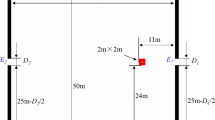Abstract
In the study, influences of fire products on pedestrians are introduced into a multi-grid evacuation model, in which the space is discretized into small grids with the size of 0.1 m × 0.1 m and each pedestrian occupies 5 × 5 grid sites. The fire products affect two walking parameters of pedestrians: the desired movement direction and the step frequency. The data of fire products are obtained from the simulation results of the Fire Dynamics Simulator (FDS), a well-founded computational fluid dynamic (CFD) program, developed by the National Institute of Standards and Technology (NIST). With this model, we investigated the routes of pedestrians in fires, and the evacuation times in scenarios with different fire intensities, pre-movement times or door widths. The results indicate that pedestrians will avoid moving towards the fire source, small fire may make egress process faster while large fire may reduce evacuation efficiency significantly, the movement time increases rapidly with the increasing pre-movement time, and the door width plays a more important role for evacuation in fire than normal condition. Furthermore, for the evacuation from a hall with two exits our model can reproduce the inefficient use of exits and predict the optimal condition that results in least evacuation time.










Similar content being viewed by others
References
Helbing D, Farkas I, and Vicsek T (2000) Simulating dynamical features of escape panic. Nature 407: 487-490
Helbing D and Molnar P (1995) Social Force Model for Pedestrian Dynamics. Physical Review E 51: 4282-4286
Muramatsu M, Irie T, and Nagatani T (1999) Jamming transition in pedestrian counter flow. Physica A 267: 487-498
Tajima Y and Nagatani T (2001) Scaling behavior of crowd flow outside a hall. Physica A 292: 545-554
Kirchner A and Schadschneider A (2002) Simulation of evacuation processes using a bionics-inspired cellular automaton model for pedestrian dynamics. Physica A 312: 260-276
Burstedde C, Klauck K, Schadschneider A, and Zittartz J (2001) Simulation of pedestrian dynamics using a two-dimensional cellular automaton. Physica A 295: 507-525
Kirchner A, Klupfel H, Nishinari K, Schadschneider A, and Schreckenberg M (2004) Discretization effects and the influence of walking speed in cellular automata models for pedestrian dynamics. J Stat Mech-Theory Exp, 10011
Song WG, Xu X, Wang BH, and Ni SJ (2006) Simulation of evacuation processes using a multi-grid model for pedestrian dynamics. Physica A 363: 492-500
Xu X, Song WG, and Zheng HY (2008) Discretization effect in a multi-grid egress model. Physica A 387: 5567-5574
Weng WG, Pan LL, Shen SF, and Yuan HY (2007) Small-grid analysis of discrete model for evacuation from a hall. Physica A 374: 821-826
Fang ZM, Song WG, Zhang J, Wu H (2010) Experiment and modeling of exit-selecting behaviors during a building evacuation. Physica A 389: 815–824
Zhang J, Song WG, Xu X (2008) Experiment and multi-grid modeling of evacuation from a classroom. Physica A 387: 5901–5909
Jin T (2002) Visibility and human behavior in fire smoke. In: DiNenno PJ, Walton WD (eds) The SFPE handbook of fire protection engineering, 3rd edn. Society of Fire Protection Engineers, Bethesda, pp 2-42–2-53
Jensen G (2002) Wayfinding in heavy smoke: decisive factors and safety products findings related to full scale tests. IGP AS
Purser D (2002) Toxicity assessment of combustion products. In: DiNenno PJ, Walton WD (eds) The SFPE handbook of fire protection engineering, 3rd edn. Society of Fire Protection Engineers, Bethesda, pp 2-83–2-171
McGrattan K, Klein B, Hostikka S, Floyd J (2004) Fire dynamics simulator (version 5), user’s guide. NIST Special Publication 1019
Peacock R, Jones W, Reneke P, Forney G (2005) CFAST—consolidated model of fire growth and smoke transport (version 6) user’s guide. NIST Special Publication 1041
Tang F and Ren A (2008) Agent-Based Evacuation Model Incorporating Fire Scene and Building Geometry. Tsinghua Science & Technology 13: 708-714
Shi J, Ren A, and Chen C (2009) Agent-based evacuation model of large public buildings under fire conditions. Automation in Construction 18: 338-347
Korhonen T, Hostikka S, Heliövaara S, Ehtamo H (2008) FDS + Evac: modelling social interactions in fire evacuation. In: Proceedings of the 7th international conference on performance-based codes and fire safety design methods, Bethesda, MD
Korhonen T, Hostikka S, Heliövaara S, Ehtamo H, Matikainen K (2007) Integration of an agent based evacuation simulation and the state-of-the-art fire simulation. In: Proceedings of the 7th Asia-Oceania symposium on fire science & technology, HongKong
Zhu W, Ding H, and Wang T (2009) The application of fire spread and evacuation simulation technology in large stadium. Stochastic Environmental Research and Risk Assessment 23: 433-439
Gwynne S, Galea ER, Lawrence PJ, and Filippidis L (2001) Modelling occupant interaction with fire conditions using the buildingEXODUS evacuation model. Fire Saf J 36: 327-357
Korhonen T, Hostikka S (2009) Fire dynamics simulator with evacuation: FDS + Evac. Technical Reference and User’s Guide. VTT Technical Research Centre of Finland
Liu X, Song WG, and Zhang J (2009) Extraction and quantitative analysis of microscopic evacuation characteristics based on digital image processing. Physica A 388: 2717-2726
Hoogendoorn SP and Daamen W (2005) Pedestrian behavior at bottlenecks. Transportation Science 39: 147-159
Forney G, McGrattan K (2004) User’s guide for Smokeview version 5-A tool for visualizing fire dynamics simulation data. NIST Special Publication
Acknowledgements
The study is supported by China National Natural Science Foundation (psychological reaction, evacuation behavior and intervention of mass crowd in unconventional emergency), and Program for New Century Excellent Talents in University (NCET-08-0518).
Author information
Authors and Affiliations
Corresponding author
Rights and permissions
About this article
Cite this article
Fang, ZM., Song, WG., Zhang, J. et al. A Multi-Grid Model for Evacuation Coupling with the Effects of Fire Products. Fire Technol 48, 91–104 (2012). https://doi.org/10.1007/s10694-010-0173-x
Received:
Accepted:
Published:
Issue Date:
DOI: https://doi.org/10.1007/s10694-010-0173-x




